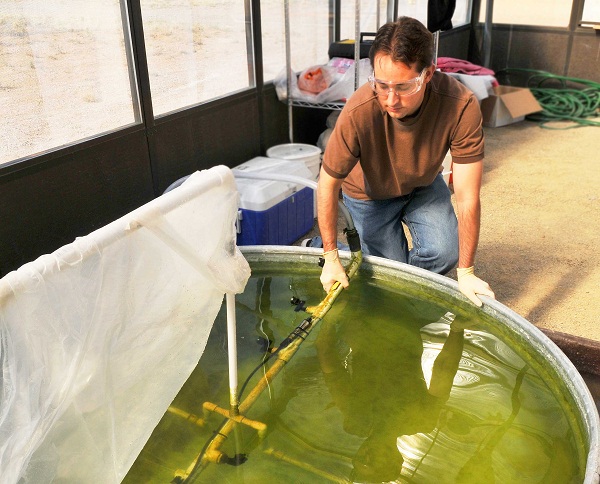Great progress has been made on producing electricity sustainably, but cracking the clean transportation fuel nut continues to be a challenge – and a new report from a committee of top researchers pulled together by the National Research Council says algal biofuels are not the tool that can do it. At least, not yet.
Several companies are already making fuels derived from algae and cyanobacteria – mostly for the military – but in tiny quanties. With hopes of scaling up, the U.S. Department of Energy called on the group of experts to investigate the sustainability issues that might arise if production grew to meet 5 percent of U.S. transportation fuel needs.

Turns out there would be plenty of issues. In a statement that accompanied the report’s release, the National Academies summarized them:
The committee pointed out several high-level concerns for large-scale development of algal biofuel, including the relatively large quantity of water required for algae cultivation; magnitude of nutrients, such as nitrogen, phosphorus, and CO2, needed for cultivation; amount of land area necessary to contain the ponds that grow the algae; and uncertainties in greenhouse gas emissions over the production life cycle. Moreover, the algal biofuel energy return on investment would have to be high, meaning more energy would have to be produced from the biofuels than what is required to cultivate algae and convert them to fuels.
This isn’t the first dour assessment of algae’s prospects. A 2011 University of Virginia study found that while algae was capable of producing high energy output, there were serious environmental concerns that accompanied its production. And beyond the sustainability question, a 2010 report from the Energy Bioscience Institute at UC Berkeley said the high costs of producing the fuels meant that the industry was at least 10 years away from economic viability.
What’s new with this study is that it pulled together experts from the U.S. national labs, from industry and from academia to issue a consensus view.
Five percent of U.S. transportation fuel needs would translate to 39 billion liters of algal biofuels. Now, there are a number of different processes out there for producing biofuels, but in scoping out the impact of reaching that 39 billion target the committee said it mirrored the focus of the nascent industry, in which “the current development involves growing selected strains of algae in open ponds or closed photobioreactors using various water sources, collecting and extracting the oil from algae or collecting fuel precursors secreted by algae, and then processing the oil into fuel.”
Using these processes, one of the major motivations for going down the algal biofuel route couldn’t be confirmed: “(E)stimates of greenhouse gas emissions over the life cycle of algal biofuel production span a wide range; some studies suggest that algal biofuel production generates less greenhouse gas emissions than petroleum-based fuels while other studies suggest the opposite,” the researchers found.
The report, however, wasn’t a complete washout for friends of algae biofuels.
The committee said that the concerns it raised don’t represent “a definitive barrier for future production,” and it outlined a framework for the Department of Energy to use in moving forward with the R&D that could be necessary to break through to the promised land of sustainability.
“(R)esearch, development, and demonstration are needed to test and refine the production systems and the mitigation strategies for sustainability concerns and to evaluate the systems and strategies based on the sustainability goals if the promise of sustainable development of algal biofuels has any chance of being realized,” the report summary said.
A free, prepublication version of the committee report is available through the National Academies Press website.